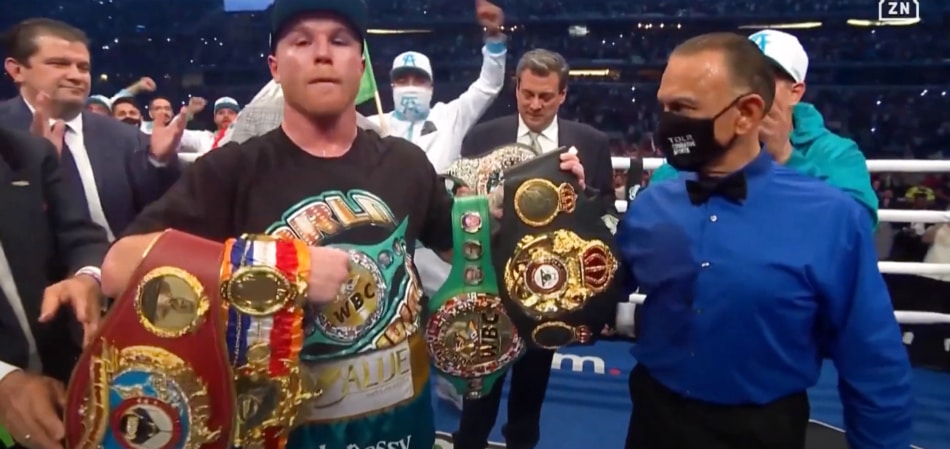
If you are a newcomer to boxing, the professional side of the sport can feel overwhelming. Not only are there multiple divisions, but each division features multiple champions. Why is that?
The short answer is money. The more championships there are in the picture, the more money organizations can make as part of their sanctioning fees. Typically, they also claim 3 percent of the purse for both the champion and challenger in a title fight. There is a reason that seemingly every notable bout is a championship fight.
With that in mind, how can you determine the real champion of any given division? Are certain belts more prestigious or legitimate than others?
History of sanctioning bodies
- World Boxing Association (WBA) – founded 1921
- The Ring world championship belt – 1922
- World Boxing Council (WBC) – founded 1963
- International Boxing Federation (IBF) – founded 1983
- World Boxing Organization (WBO) – founded 1988
Up until the 1920s, there were only lineal champions. In order to gain that title, you needed to beat the reigning champion. It was that simple.
In 1921, the landscape began to change. The National Boxing Association was formed, and it crowned Jack Dempsey as the heavyweight champion after he defeated Georges Carpentier. From that point forward, the NBA champion was viewed as the only legitimate champion. In 1962, the NBA became the WBA (World Boxing Association) and assumed the role of the first proper sanctioning body in professional boxing.
However, there were serious issues plaguing the organization. Firstly, most WBA fights only involved Americans. The title of “best in the world” didn’t seem appropriate because the world wasn’t adequately represented. Secondly, many bouts were fixed by the mob.
In an effort to eliminate that corruption, 11 countries launched the WBC (World Boxing Council) in 1963:
- United States (and Puerto Rico)
- Argentina
- United Kingdom
- France
- Mexico
- The Philippines
- Panama
- Chile
- Peru
- Venezuela
- Brazil
However, it fell prey to the same problems that the WBA encountered.
In 1983, United States Boxing Association president Robert Lee tried and failed to become president of the WBA. In response, he created the IBF (International Boxing Federation) as the third major sanctioning body. Despite appearing legitimate at first, the organization ran into significant legal problems in the late 1990s. In 2000, Lee was convicted of money laundering and tax evasion.
In 1988, the last major sanctioning body was formed: the WBO (World Boxing Organization). By that point, though, there were already too many titles to keep track of.
Of course, there are other sanctioning bodies in play, but these four are perceived as the most important.
The IBO (International Boxing Organization), also started in 1988, is a curious case and perhaps best known for employing a computerized ranking system. It will occasionally include its belt in a big fight (e.g. Anthony Joshua vs. Wladimir Klitschko), but it does not carry as much importance as the other four major sanctioning bodies.
Even if a fighter holds an IBO belt, they are not seen as a true champion unless they also possess a belt from another big organization.
Though it is not a sanctioning body, The Ring magazine has also crowned champions for a long time (1922-1990s, 2001-present). Many believe its rankings are the most accurate because the publication doesn’t charge sanctioning fees. It has no skin in the game. Instead, it merely seeks to determine the cream of the crop.
Weight classes
Another reason for the staggering number of championship belts is the number of divisions in professional boxing. There used to be eight weight classes, but the sport now boasts 17 different divisions.
They are listed below from lightest to heaviest (weight limit in parentheses):
- Minimumweight (105 lbs)
- Light flyweight (108 lbs)
- Flyweight (112 lbs)
- Super flyweight (115 lbs)
- Bantamweight (118 lbs)
- Super bantamweight (122 lbs)
- Featherweight (126 lbs)
- Super featherweight (130 lbs)
- Lightweight (135 lbs)
- Super lightweight (140 lbs)
- Welterweight (147 lbs)
- Super welterweight (154 lbs)
- Middleweight (160 lbs)
- Super middleweight (168 lbs)
- Light heavyweight (175 lbs)
- Cruiserweight (200 lbs)
- Heavyweight (unlimited)
Fighters must abide by these limits at the weigh-ins that take place on the eve of the bout. In other words, fighters who would be too heavy for their weight class any other time can still fight in that division by cutting weight in the weeks leading up to the contest. For instance, a lightweight fighter could manipulate their weight to meet the 135-pound limit at the weigh-ins and then show up weighing 145 pounds on the day of the actual fight.
The combination of multiple sanctioning bodies and 17 different weight classes has resulted in a ridiculous number of championship belts.
Types of belts
Despite a seemingly endless number of belts, they are not all created equal.
In the WBA, there are “regular” and “super” champions. A regular champion only holds the WBA title. If they win a belt from one of the other major sanctioning bodies, they become the super champion of that division. When this happens, the regular title becomes vacant and two contenders are chosen to fight for it. The super champion is usually viewed as the true champion.
The WBC adds to the confusion with a number of different titles. The “Diamond” belt is awarded to the winner of a historic fight (e.g. Floyd Mayweather vs. Manny Pacquiao). The WBC Eternal Championship is an honorary title given to a fighter who never lost a world title and retired undefeated. A “silver” belt is a secondary belt.
Then there are interim titles, which are handed out while a champion is inactive (typically due to injury). Interim champions are not perceived to be true champions. There are also Emeritus titles. These are tendered to former world champions who retire with the possibility of returning some day. If they do, they can become the mandatory challenger for a world title.
So which of these titles really matter?
Frankly, the most important titles aren’t associated with one specific belt. The lineal champion can be traced back to the very beginning of the sport. There is a certain distinction that comes with being “the man who beat the man.” The unified champion holds two or more belts from the major sanctioning bodies. Finally, the undisputed champion owns all four major belts.
Obviously, nothing trumps the status of undisputed champion.
In the four-belt era, there have been five undisputed men’s champions:
- Oleksandr Usyk (cruiserweight)
- Bernard Hopkins (middleweight)
- Jermain Taylor (middleweight)
- Terence Crawford (junior welterweight)
- Josh Taylor (junior welterweight)
Controversy
Some fighters may enjoy the abundance of championship belts because their odds of winning one—even from a less prominent organization—are higher. However, this can confuse casual fans. After all, there are multiple champions in each division.
Moreover, this isn’t ideal for competitive integrity. Sanctioning bodies may book contests between popular fighters simply because they can collect higher fees that way. As a result, we don’t always get to see the best square off against each other and thus determine who truly reigns atop a certain division.
In October 2020, former undefeated legend Floyd Mayweather discussed the issues surrounding the number of belts:
“People don’t know you have to pay, for every belt that you win, there’s a sanctioning fee. So now, if a fighter wins an interim belt, he has to pay a sanctioning fee. If a fighter has just the regular belt, he has to pay a sanctioning fee. Then, if a fighter is a super champion, then he has to pay a sanctioning fee.
This is not good for the sport of boxing. Now, when a fighter fights, every fighter is a champion now. Belts now is like a fighter winning an amateur trophy. Everybody is a champion. Everybody have a belt.”
While the sanctioning bodies are profiting from this situation, the belts themselves have become devalued. There is no prestige to being a champion if there are other champions in that same division everywhere you look.
It’s hard to see a solution to this problem because the organizations that take a cut from every fight are so embedded in the business of the sport.
With that said, the WBA recently announced a plan to reduce the number of belts it hands out. The first step has been to remove all interim titles. It remains to be seen whether other sanctioning bodies will follow in the WBA’s footsteps. That seems unlikely for now.
Conclusion
Since there are four major sanctioning bodies and 17 different weight classes, there are a lot of championship belts to keep track of. As a new or casual fan, following each one closely is not required. All you need to know is that being a unified or undisputed champion is more important than holding the title from one particular organization.
Undisputed champions are few and far between these days because of the politics involved in the sport. Promoters will try to protect their clients from dangerous fights while making as much money as possible in the meantime.
But when a fighter does reach the title of undisputed champion, it’s a massive accomplishment that should be celebrated because they actually beat the best talent in their division.



